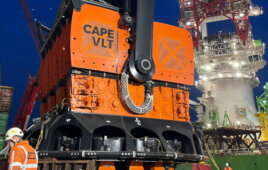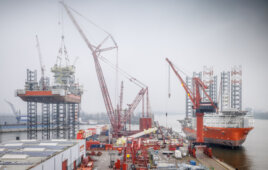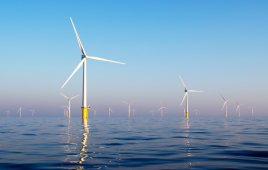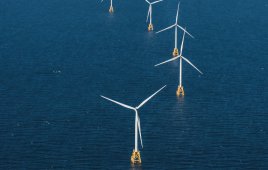Recent estimates for a 2.0 MW turbine intended for an 80-m tower provide an example of the uncertainty in power predictions based on data from short (60m) met towers. The plots below were calculated from several wind shear models (in the box). Wind shear is a way of estimating higher level winds from lower-level measurements.

The colored plots come from different math models for wind shear. These are fitted to measured data of mean wind speed.
The Mean wind speeds (second column) in the table were collected during a site assessment at a particular location.
“The standard deviation in the middle column represents the uncertainty in wind shear,” says WindPole president Steve Kropper.
“The uncertainty in the mean wind speed (Col 3) over the sample set and the resulting uncertainty over the measured power-production time frame are for multiple sensor heights at one location,” he adds. Results indicate that without a sensor at the 80-m height, there would be an additional uncertainty in energy production of roughly 14.1% versus having a sensor installed at the turbine’s hub height. To find the 90% confidence interval (i.e. P90) for the cumulative annual-energy production, wind speed data from the 80m sensor is rescaled several times by randomly sampling errors from a normal distribution of annual mean wind speeds (i.e. the mean wind speed of 6.65 m/s provides a standard error of 5.5%) and applying each newly rescaled time series to the power curve of a sample Gamesa G87 2.0 MW turbine at 80m whose MWh output is summed for the entire year for each sample created.
With regard to the P-90 column, the error is the percent difference in P90 when the sensor at 80m is missing. One must perform vertical extrapolation from 40-m height.
P90 represents the 90% confidence interval in cumulative annual energy production. Only the uncertainty in wind shear is considered for this calculation (others may be present).
“We believe other sites may experience significantly more uncertainty when wind speeds are extrapolated. This research supports earlier findings that actual hub height tall tower data (versus extrapolation from short towers) reduces forecast risk. What’s more, the improved P-90 outlook lets developers negotiate more attractive financing terms,” says Kropper.
WindPole Ventures
windpole.com
Filed Under: News





Both this article and the government’s press release both miss a major point. For power to be converted to a useful number we need to know the time it will provide it for.
So providing the average power over a year would enable us to assess the planned output and then start to understand the storage required for the peaks and troughs.
So please give an anticipated average power or a predicted kWh per year. Then myself Mr Oliver and R.Jays will be very happy.
To say it varies depending on many factors is plan daft as you must have a number for a business plan to sell to customers.
I can guess 1/2 power for an average of 4 hours per day = 1,460MWh/annum
Enough for 18.25 of our 65 million people’s annual power requirement (all lifestyle consumption).
By the way I am a strong supporter but need facts or reasonable estimates.
R. Jays – I wish it were as simple as that. Unfortunately there are just too many variables to accurately give any sort of generalized number. However, a typical turbine when sited correctly can produce about 30% of it’s power rating. Again, this is too general to be remotely accurate, but since you need a number….
all I wanted to know was
How much will that 2 MW turbine really produce?
Here in the UK obtaining temporary planning permission for even a 50m met mast can be a fraught business, as such proposals almost always engender local opposition. Moving toward an 80m met mast (assuming there are some that do not demand a lattice-type construction) would certainly increase developer’s certainty when it came to energy estimates, but rather perversely it would decrease their chances of getting permission to erect the mast in the first place due to increased concerns about visual impact, bird strike etc. Energy yield assessments always appear to be a bit of a dark art and so some more reliable data would not go amiss. I do wonder however, whether simply sharing data among developers more freely might have a similar impact on increasing accuracy of predictions.
I’m just curious – why does this article not address the question raised in the title?
I mean I know it discusses the uncertainty of measurements, but not once does it give any kind of indication about the actual amount of power that a 2MW turbine might produce (with or without a degree of uncertainty).
Just mentioning a figure, say 200MWhrs/year +/- 50MWhrs would answer the question.